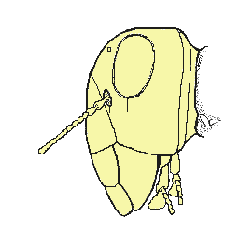Antennae
The antennae are a pair of sense organs located near the front of an insect’s head capsule. Although commonly called “feelers”, the antennae are much more than just tactile receptors. They are usually covered with olfactory receptors that can detect odor molecules in the air (the sense of smell). Many insects also use their antennae as humidity sensors, to detect changes in the concentration of water vapor. Mosquitoes detect sounds with their antennae, and many flies use theirs to gauge air speed while they are in flight.



